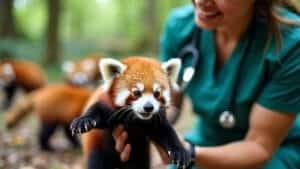Introduction
Red pandas live vastly different lives in the wild compared to those in zoos, with variations in habitat, diet, behavior, and lifespan. In the wild, red pandas roam the temperate forests of the Himalayas, eating mostly bamboo and facing natural challenges like predators and climate
In zoos, they live in specially designed enclosures with managed diets, regular veterinary care, and enrichment activities. While zoos play a crucial role in red panda conservation, these differences in environment and lifestyle affect everything from their health and behavior to their breeding and longevity
This article explores the key differences between wild and captive red pandas, shedding light on how each setting impacts their lives and conservation
Differences in Habitat Between Wild and Zoo Red Pandas
The habitats of red pandas in the wild are dramatically different from those in zoos. In the wild, red pandas live in the temperate forests of the Himalayas and southwestern China, where they have access to a complex and diverse ecosystem
In contrast, zoo enclosures are specifically designed to replicate aspects of their natural environment, but certain limitations come with living in a managed, controlled setting
Red Pandas’ Natural Habitat in the Wild
In the wild, red pandas inhabit cool, temperate forests at elevations ranging from 4,900 to 13,000 feet, primarily in the Himalayas, including parts of Nepal, Bhutan, India, and southwestern China
These forests are dense with bamboo, a key food source for red pandas, and feature a mix of broadleaf and coniferous trees. The high-altitude environments provide a climate that is crucial for red pandas, as they thrive in cool temperatures and struggle in excessive heat. Their thick, fur-covered bodies are adapted to these cold, misty forests, where they spend much of their time in trees, using their strong claws to climb and forage
Red pandas in the wild are solitary creatures, establishing large territories that they mark with scent glands. They navigate complex landscapes filled with natural hiding spots, food sources, and opportunities for exercise and exploration
These habitats allow them to perform their full range of natural behaviors, from foraging for bamboo to climbing trees and avoiding predators
The wild offers red pandas more freedom and variability, but they also face threats like habitat loss due to deforestation, poaching, and climate change, which can reduce their chances of survival
Zoo Enclosures and Enrichment for Red Pandas
In zoos, red pandas live in enclosures designed to mimic the natural environment as closely as possible, but the controlled nature of the setting imposes some limitations
Zoo habitats typically include trees for climbing, elevated platforms, and shaded areas to provide cooler temperatures similar to their wild environments. The enclosures are often enriched with climbing structures, ropes, and hiding spots to encourage natural behaviors like foraging and exploring
While these enclosures are carefully designed, they cannot fully replicate the complexity and size of a red panda’s natural territory in the wild. Zoo enclosures tend to be much smaller, which limits the distance red pandas can travel, climb, or forage
Additionally, zoo environments are predictable and controlled, meaning red pandas in captivity do not face the same variety of challenges or stimuli as their wild counterparts. However, zoos compensate for this by offering enrichment activities that stimulate their instincts, such as puzzles that require problem-solving or hidden food items that encourage foraging behaviors
For instance, many zoos provide enrichment objects like scent-marked toys, bamboo bundles, and logs to encourage red pandas to use their climbing and foraging skills. Some zoos also use cooling systems or design their enclosures to offer red pandas the cooler environments they prefer, ensuring their well-being in warmer climates
How Habitat Affects Red Panda Behavior and Health
The difference in habitats between the wild and zoos significantly impacts red panda behavior and health. In the wild, red pandas exhibit more natural behaviors, such as foraging for bamboo for several hours a day, climbing trees to rest or escape predators, and marking their territory. These activities help keep wild red pandas physically active and mentally engaged
In zoos, red pandas may display less of their natural behaviors due to the more controlled environment. For example, they might climb less frequently or spend more time resting because their food is more readily available, and they do not need to defend large territories
To address this, zoos implement enrichment programs that aim to stimulate physical and mental activity, encouraging red pandas to explore and engage with their surroundings
The health of red pandas in zoos can be both positively and negatively impacted by the environment. On the positive side, zoo red pandas benefit from regular veterinary care, a consistent food supply, and protection from predators and harsh environmental conditions. This care often leads to longer lifespans compared to their wild counterparts
However, without adequate enrichment, red pandas in captivity can suffer from stress or obesity, as their physical activity levels may decrease in a confined space
Research by Sarkar and Wei (2012) indicates that while zoo environments provide safety and regular care, the lack of environmental complexity in comparison to the wild can affect a red panda’s physical and mental well-being
The study emphasized the importance of enrichment and habitat design to ensure that captive red pandas remain healthy and engaged
Diet and Nutrition of Wild vs. Zoo Red Pandas
The diet of red pandas in the wild differs significantly from that of those in zoos, both in terms of variety and nutritional content
While wild red pandas rely almost exclusively on bamboo, zoo red pandas are provided with more controlled and varied diets that are designed to meet their nutritional needs while accounting for the challenges of captivity
Bamboo as the Primary Food Source in the Wild
In the wild, red pandas have a specialized diet that consists primarily of bamboo. This plant, while abundant in their natural habitats, is low in nutritional value, forcing red pandas to consume large quantities to meet their energy needs
On average, a wild red panda can eat about 2 to 4 pounds of bamboo leaves and shoots daily. Despite being classified as carnivores, red pandas have adapted to a primarily herbivorous diet, with their digestive systems better suited to processing fibrous plant matter than to breaking down meat
Wild red pandas tend to be selective in their bamboo consumption, eating the most tender shoots and leaves when available. Their diet can also include seasonal fruits, acorns, berries, and sometimes small insects or eggs to supplement their low-calorie bamboo intake
This foraging behavior requires them to spend a significant portion of their day searching for food, particularly in the cooler months when bamboo shoots are less available
The reliance on bamboo presents challenges for red pandas in the wild, especially as deforestation and habitat fragmentation reduce the availability of this critical food source. In areas where bamboo forests are degraded, red pandas may struggle to find enough food, leading to malnutrition and a decline in population numbers
Zoo Diets for Red Pandas: Supplementation and Nutrition
In zoos, red pandas are given more diverse diets that are specifically formulated to ensure they receive adequate nutrition. While bamboo remains a core part of their diet in captivity, zoo red pandas also eat specially prepared biscuits, fruits, and vegetables to supplement their nutritional intake
These additional food sources are designed to provide the calories and nutrients that may be lacking in bamboo alone, such as proteins, fats, and vitamins
The use of nutritionally balanced biscuits is common in zoos, as they help maintain the health of red pandas without requiring them to consume massive quantities of bamboo
These biscuits are often high in fiber to mimic the red panda’s natural diet but are fortified with additional nutrients to prevent deficiencies. Zoos may also offer treats like apples, grapes, and other fruits, which red pandas enjoy and which help keep them hydrated
Zoo diets are carefully monitored and adjusted based on the red panda’s age, health, and activity level. Zookeepers closely track each animal’s weight and overall condition to ensure that their diet meets their needs without leading to obesity or other health issues. While zoo red pandas benefit from a steady and reliable food supply, their foraging behaviors are often reduced, leading zoos to introduce enrichment strategies that encourage natural eating habits
For example, many zoos hide food items around the enclosure or provide bamboo in ways that require red pandas to forage or work to access it, mimicking the behaviors they would display in the wild. These enrichment techniques not only promote physical activity but also help maintain mental stimulation
Research by Glatston (2011) highlights the nutritional challenges of maintaining red pandas in captivity, noting that zoos must carefully balance their diet to prevent health issues such as obesity, which can occur if red pandas consume too many calorie-dense foods and do not get enough exercise
How Diet Impacts Health in Captivity vs. the Wild
The differences in diet between wild and zoo red pandas have a direct impact on their health and well-being. In the wild, red pandas face the challenge of obtaining enough bamboo to meet their energy requirements, which can be particularly difficult during colder months when bamboo shoots are less available
This scarcity of food can lead to malnutrition, especially in degraded habitats, and wild red pandas must expend significant energy foraging to survive
In zoos, red pandas are provided with a consistent and nutritionally balanced diet, which can lead to better overall health and longer lifespans compared to their wild counterparts. However, the controlled nature of zoo feeding, combined with a less physically demanding lifestyle, can sometimes lead to issues like obesity if their diet is not carefully managed
Zoo red pandas may be less active due to the availability of food, and without proper enrichment and exercise opportunities, they can become overweight or develop health problems related to inactivity
Zoo veterinarians play a crucial role in managing the health of red pandas, adjusting their diet based on individual needs and providing regular check-ups to monitor their weight and condition
In contrast, wild red pandas must rely on the availability of bamboo and other natural food sources, which are influenced by environmental conditions, making their survival more precarious
Behavioral Differences in Captive and Wild Red Pandas
The behavior of red pandas differs greatly between those in the wild and those living in zoos
While the natural environment provides challenges that shape the red panda’s daily activities and survival strategies, captivity introduces a more controlled setting where behaviors are influenced by factors like enclosure design, feeding schedules, and human interaction
These differences impact everything from their activity levels to social interactions and stress management
Natural Behaviors of Red Pandas in the Wild
In the wild, red pandas are solitary and elusive animals that are primarily active during dawn and dusk, exhibiting crepuscular behavior. They spend a significant portion of their time foraging for bamboo, which can take up several hours each day due to the low nutritional value of their diet
The need to consume large amounts of bamboo and occasionally supplement their diet with fruits, acorns, and small animals makes red pandas active foragers
Red pandas are expert climbers, using trees for rest, safety, and to avoid predators like snow leopards and martens. They are known to be territorial and mark their home ranges with scent glands located on their paws and anus, as well as through urine spraying
These scent-marking behaviors help them establish boundaries and communicate with other red pandas in the area, despite their solitary nature
Seasonal changes also influence red panda behavior in the wild. In colder months, red pandas tend to conserve energy by being less active and curling up with their bushy tails for warmth. During the breeding season, typically in late winter or early spring, males may become more active as they search for mates, though red pandas generally prefer to avoid confrontation
The challenges of finding food, evading predators, and navigating their complex natural habitats keep wild red pandas physically and mentally engaged, leading to a lifestyle that demands high levels of independence and resourcefulness
Behavioral Enrichment in Zoos to Mimic Wild Activity
In captivity, red pandas live in controlled environments where food is readily available and predators are absent, leading to differences in their daily activities
Without the constant need to forage for bamboo or defend territories, captive red pandas may display lower levels of activity compared to their wild counterparts. To address this, zoos implement behavioral enrichment programs designed to encourage natural behaviors and prevent boredom or stress
Enrichment activities in zoos often include:
Foraging puzzles: Keepers hide food in puzzle feeders or scatter bamboo and treats throughout the enclosure to encourage red pandas to explore and search for their meals, mimicking their natural foraging behavior
Climbing structures: Zoos provide elevated platforms, ropes, and tree branches to simulate the forested habitats where red pandas would normally climb and rest. These structures help maintain their climbing skills and offer exercise
Scent enrichment: To replicate their natural territorial marking behaviors, zoos may introduce novel scents or objects into the enclosure, stimulating the red pandas’ curiosity and encouraging them to investigate and mark their space
Seasonal activities: Some zoos offer seasonal enrichment by providing snow in the winter or adjusting enclosure conditions to reflect changes in temperature, helping red pandas engage with their environment more naturally
These enrichment strategies aim to keep zoo red pandas physically active and mentally stimulated, ensuring they exhibit behaviors that closely resemble those of wild red pandas. However, even with enrichment, zoo environments cannot fully replicate the complexities of a wild habitat, where red pandas must navigate larger territories, face environmental challenges, and avoid predators
How Captivity Affects Red Panda Social Behavior
Red pandas are solitary animals, and in the wild, they rarely interact with other red pandas outside of the breeding season
However, in zoos, they may be housed with other red pandas, particularly if part of a breeding pair or family group. While red pandas are generally non-aggressive, they can show territorial behaviors or stress if kept in close proximity to others for extended periods
In zoos, red pandas may be more tolerant of sharing space with others due to the absence of competition for food or resources. Still, zoos carefully monitor their social dynamics to ensure that red pandas remain comfortable and exhibit natural behaviors
During the breeding season, zoos may allow males and females to interact more frequently to encourage mating, but outside of this period, red pandas are often housed separately to reduce stress
Captivity also affects the way red pandas engage with their environment. Without the need to constantly defend their territory, zoo red pandas may scent mark less frequently or display fewer territorial behaviors compared to wild red pandas. However, they may still engage in these behaviors as part of their natural instincts, particularly if enrichment activities are designed to encourage scent-marking
Stress management is another important consideration in captivity. While wild red pandas face stress from predators and environmental challenges, zoo red pandas may experience stress from human interaction, changes in their routine, or lack of stimulation
To mitigate this, zoos often design enclosures that allow red pandas to retreat to secluded areas if they need privacy, and they carefully manage human-animal interactions to minimize disturbances
Research by Smith (2015) highlights the importance of behavioral enrichment in captivity, noting that red pandas are less likely to display signs of stress or boredom when provided with opportunities to engage in natural behaviors. The study found that zoos that prioritize enrichment and allow red pandas to express their natural instincts tend to have healthier, more active animals
Breeding, Health, and Lifespan of Red Pandas in Zoos vs. the Wild
The breeding, health, and lifespan of red pandas vary significantly between those in the wild and those in captivity
Zoos provide controlled environments with regular veterinary care, nutritional support, and protection from predators, leading to longer lifespans and higher reproductive success compared to wild red pandas
However, captivity also presents unique challenges, such as managing genetic diversity and ensuring that animals remain physically and mentally healthy
Red Panda Reproduction in Captivity vs. the Wild
Breeding patterns in wild red pandas differ from those in captivity due to environmental factors, availability of mates, and survival pressures. In the wild, red pandas have a relatively short breeding season, typically between January and March
Mating is brief, and after a gestation period of about 135 days, females give birth to one to four cubs in tree hollows or dense thickets. Wild red pandas face challenges such as predation, food scarcity, and harsh environmental conditions, which can affect cub survival rates. Many cubs do not reach adulthood due to these pressures
In contrast, red pandas in zoos benefit from carefully managed breeding programs that are part of global conservation efforts like the Species Survival Plan (SSP)
These programs ensure that genetically diverse pairs are selected to maintain healthy populations in captivity. In zoos, red pandas receive regular health checks during pregnancy, and their cubs are monitored closely after birth to ensure they are growing and developing properly
Zoo environments also offer higher survival rates for cubs, as the threats they face in the wild—predators, food scarcity, and environmental stressors—are absent. Zoos provide secure, climate-controlled enclosures where females can raise their cubs without disturbance. Additionally, zoo veterinarians can intervene if complications arise during pregnancy or birth, further increasing cub survival rates
However, managing breeding in captivity comes with its own challenges. Zoos must carefully plan breeding to avoid inbreeding and ensure genetic diversity across captive populations
Some zoos may need to transfer red pandas to different facilities to match genetically compatible mates, which requires coordination among conservation organizations worldwide
Health Monitoring and Veterinary Care in Zoos
One of the most significant differences between wild and zoo red pandas is the level of health care they receive. In the wild, red pandas are vulnerable to a range of health threats, including diseases, injuries, and malnutrition, and they do not have access to medical care
Illness or injury can quickly become life-threatening, especially in harsh climates where food is scarce or predation risk is high
In zoos, red pandas receive regular veterinary care, which significantly improves their overall health and well-being. Zoo veterinarians perform routine health checks, vaccinations, and dental care, ensuring that any health issues are caught early and treated promptly
Red pandas in zoos are also protected from many of the diseases they might encounter in the wild, and their enclosures are designed to minimize the risk of injury
Zoo red pandas benefit from a controlled diet that ensures they receive all the necessary nutrients, reducing the likelihood of malnutrition. In cases where a red panda requires medical intervention, zoos are equipped with specialized facilities to provide treatments such as surgeries or medication
These interventions, along with constant monitoring, allow red pandas in zoos to live healthier lives compared to their wild counterparts
However, zoo red pandas may face unique health challenges related to captivity, such as obesity or stress-related behaviors if their diets or enrichment are not adequately managed. Zoos address this by providing structured feeding schedules, balanced nutrition, and physical activity through enrichment programs
Research by Reed (2011) shows that red pandas in zoos generally have better health outcomes and longer lifespans due to the comprehensive veterinary care they receive. The study highlights the role of preventive care in reducing mortality rates and ensuring the longevity of captive red panda populations
Comparing Lifespan and Mortality Rates in Captivity and the Wild
The lifespan of red pandas in captivity is generally longer than that of their wild counterparts due to the protection and care they receive in zoos
In the wild, red pandas have an average lifespan of 8 to 10 years, though many do not reach this age due to threats such as predation, disease, and habitat loss. The constant struggle to find food, avoid predators, and survive in challenging environments takes a toll on wild red pandas, leading to shorter lifespans
In zoos, red pandas can live up to 15 years or more, thanks to the absence of predators, regular feeding, and medical care. The controlled environment reduces the stressors that wild red pandas face, allowing them to live longer, healthier lives
Zoos also closely monitor aging red pandas, providing specialized care to manage age-related conditions such as arthritis or dental problems
While zoos provide a safe environment for red pandas, longevity can also bring challenges, such as the need for more intensive medical care as the animals age. Some zoo red pandas may develop conditions related to aging that would not commonly be seen in the wild due to their shorter natural lifespan
The higher life expectancy of zoo red pandas also has implications for conservation, as it allows for longer breeding opportunities and the continued success of captive populations. However, the need to manage aging populations in zoos adds complexity to veterinary care and enclosure management
Research by Sarkar and Wei (2012) found that captive red pandas typically live 5 to 7 years longer than those in the wild, with the primary factors being consistent nutrition, the absence of predators, and access to medical care
The study underscores the importance of zoos in providing a safe and healthy environment for endangered species like the red panda
Conclusion
Red pandas in the wild and in zoos experience vastly different lives, shaped by their environments, diets, behaviors, and health care. In the wild, red pandas face the challenges of foraging for bamboo, avoiding predators, and navigating the rugged landscapes of the Himalayas, all while contending with habitat loss and environmental threats
These challenges keep them physically and mentally active, but also reduce their lifespans and increase their risk of malnutrition and injury
In contrast, red pandas in zoos benefit from controlled environments that provide regular, nutritionally balanced diets, comprehensive veterinary care, and protection from predators. Zoo red pandas often live longer and healthier lives, thanks to the absence of environmental stressors and the efforts of zoo staff to simulate natural behaviors through enrichment programs
However, the structured and predictable nature of zoo life can lead to behavioral changes, such as reduced activity or stress if proper enrichment is not provided
Both settings—wild and zoo—play crucial roles in the survival of the species. In the wild, red pandas contribute to the ecological balance of their habitats, while zoos offer a sanctuary for breeding and conservation programs that help ensure the species’ long-term survival
Zoos also raise awareness about the plight of red pandas and support global conservation efforts aimed at protecting these unique animals and their habitats in the wild
By understanding the differences between wild and captive red pandas, we can better appreciate the complexities of conservation and the efforts required to protect these endangered animals in both settings









